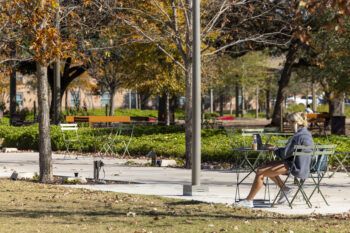Study Suggests People In Urban Areas With More Green Space Have Better Mental Health

A new study from the Texas A&M University School of Public Health suggests that city dwellers who have more exposure to urban green spaces require fewer mental health services.
The study, published in the International Journal of Environmental Research and Public Health, was conducted by Jay Maddock, Ph.D., Regents Professor of environmental and occupational health at Texas A&M, and colleagues from the Center for Health and Nature, a collaboration between Texas A&M Health, Houston Methodist and Texan by Nature. Maddock also directs the center.
The researchers measured urban greenness with NatureScore, which uses numerous data sets related to factors such as air, noise and light pollution, parks and tree canopies to calculate the amount and quality of natural elements for any known address in the United States and several other countries. Scores range from 0-19 points for Nature Deficient to 80-100 for Nature Utopia.
For addresses, they used data on mental health visits aggregated at the ZIP code level from Texas Hospital Outpatient Public Use Data Files from 2014 to mid-2019. The data contained information about patient encounters, including a patient’s age, gender, race/ethnicity, educational attainment, employment status, poverty level, principal diagnosis and ZIP code, although no patients were identified.
“The association between exposure to nature and better mental health is well established in the United States and elsewhere, but most studies use just one or two measurements of this exposure,” Maddock said. “Our study was the first to use NatureScore, which provides more complex data, to study the correlation between urban nature exposure and mental health.”
A total of 61,391,400 adult outpatient encounters in Texas cities for depression, bipolar disorders, stress and anxiety were selected. The sample included data from 1,169 ZIP codes in urban Texas, with a median NatureScore of 85.8. About half of the sample had high NatureScores (80+), and about 22 percent had NatureScores below 40.
Of these encounters, 63 percent were women, 30 percent were 65 years old or older, 54 percent were non-Hispanic white, and 15 percent were Hispanic. At the ZIP code level, 27 percent of the total population had a bachelor’s degree, 58 percent were employed, 14 percent lived under poverty, and 17 percent lacked health insurance coverage. The percentage of those 65 years old and older, white, Hispanic and employed were higher in areas with a higher NatureScore. In addition, the ZIP codes with a higher NatureScore had lower percentages of people who were Black, living in poverty or without insurance.
The trend for various mental health encounters decreased as the NatureScore of a neighborhood increased, and the rates of mental health encounters were about 50 percent lower in neighborhoods with NatureScores over 60. Those who lived in neighborhoods with the two highest NatureScore categories — Nature Rich and Utopia — had significantly lower rates of mental health encounters compared to neighborhoods with the lowest NatureScore category.
“We found that a NatureScore above 40 — considered Nature Adequate — seems to be the threshold for good mental health,” Maddock said. “People in these neighborhoods have a 51 percent lower likelihood of developing depression and a 63 percent lower likelihood for developing bipolar disorders.”
The study’s lead author, Omar M. Makram, noted that these findings could have important implications for urban planning.
“Increasing green space in cities could promote well-being and mental health, which is critically important given that more than 22 percent of the adult population in the United States with a mental health disorder,” he said.
This article by Ann Kellett originally appeared on Vital Record.





